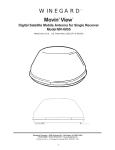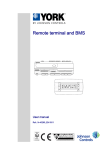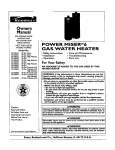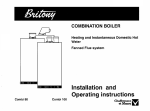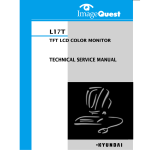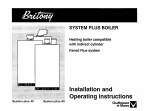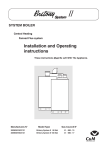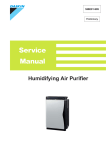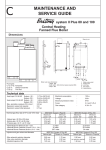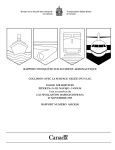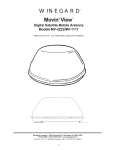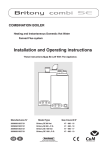Download Chaffoteaux & Maury Britony Combi SE Technical data
Transcript
-=GvAA MAINTENANCE AND SERVICE GUIDE CC Edition et COMLEC 4/95 combi 80 and 100 Fanned Flue Combination Boiler Heating and Instantaneous Domestic Hot Water Dimensions JKLMN ‘lue types: : 12 C 22 or C42: horizontal :32xx: vertical concentric Boiler outer case dimensions : Height : 850 - Boiler width : 440 (minimum space required 450) - Depth : 380 I I J K L M N Safety valve outlet Heating flow D.H.W. flow Gas supply Cold water inlet Heating return Technical data Heat input C/H & DHW Combi 80 : Combi 100 : Heat output C/H & DHW Combi 80 : Combi 100 : Max. operating pressure C/H circuit : : Expansion vessel net capacity : Expansion vessel initial pressure Electrical consumption : Voltage Electrical protection index Fuses : Nominal gas flow rate at 15°C and 1013 -Natural gas ( G 20) at 20 mbar -Butane gas ( G 30 ) at 28 mbar -Propane gas (G 31 ) at 37 mbar Injectors and gas valves seat diameter -Blue solenoid restrictor diameter -Black solenoid restrictor diameter -Manifold injectors (16) 11.73 to 28.70 kW 15.43 to 34.57 kW 9.5 to 23.25 kW 12.5 to 28 kW 2.5 bar 5.4 I 0.7 bar 15ow 230 v IP24 2Aand 1.25A BRITONY mbar Maximum power 23.25 kW 2.74 m3/h 2.04 kg/h 2.00 kg/h DHW flow rate at @ 30°C Combi 80 : Combi 100 : DHW flow rate at @ 35°C Combi 80 : Combi 100 : Minimum DHW operating flow rate : : Minimum DHW working pressure : Maximum DHW working pressure Gas category : Combi 80 Minimum power 9.5 kW 1.22 m3/h 0.91 kg/h 0.89 kg/h BRITONY Combi 80 Butane or Propane Natural qas 1.74 mm 2.40 mm 4.25 mm 5.00 mm 0.72 mm 1.23 mm 11.1 I/min 13.4 I/min 9.54 I/min 11.5 I/min 2 I/min 0.1 bar 10 bar II 2E+ 3+ BRITONY Combi 100 Minimum Maximum power 12.5 kW power 28.2 kW 3.34 m3/h 2.45 kg/h 2.42 kg/h 1.57 m3/h 1.17 kg/h 1.15 kg/h BRITONY Combi 100 1 Butane or Propane Natural qas 1.90 mm 2.80 mm 3.80 mm 5.20 mm 0.76 mm 1.26 mm Pump and expanssion vessel characteristics bar Hauteurmanomemque m 13 5 I,7 1 13 3 I,3 2 1 0 1,I DPbd 100 200 300 400 5OD 600 700 800 utl 03 0,7 1 = by-pass closed 2 = by-pass open 20 50 100 150 200 250 c (I) Note : The system initial pressure should be over the following value : System static height (in metre) + 0.7 = Initial pressure (in bar) 10 Head available / flow Components 1. CH Flow isolating valve 2. DHW outlet 3. Gas service tap 4. Water service tap 5. CH Return isolating valve location 7. Pressure relief valve 8. Chassis 9. Connecting tails (x 5) 8 3 10. Steel chassis complete with expansion Jesse1 11. Sealed chamber 12. Expansion vessel (not visible) 13. Overheat thermostat 14. Electrical box 15.Three position selector switch 16. User’s guide 17. Heating flow temperature adjustment 18. CH pressure gauge 20. Green indicator - Power ON 21. Orange indicator - Burner ON ?2. Red indicator - Lock out/flame failure ?3. Reset button 2 4 95 24. Multigas burner comprising: -25. 16 burner head -26. Manifold -27. 2 Ignition electrode -28. lonization electrode 29. Gas section comprising: -30. Security valve (grey) -31. l/3 gas stage (blue) -32. 2/3 gas stage (black) 33. Right hydraulic assy 34. Left hydraulic assy 35. Single speed pump 36. Air separator 37. Heating thermistor 38. DHW thermistor 7 39. Combustion chamber made of aluminium coated steel with 4 ceramic fibre panels to insure heat insulation 40. Copper main exchanger 41. Stainless steel secondary plate exchanger 42. Three way valve 43. connecting bracket 44. DHW flowstat 45. Heating flowstat 46. Flue hood 47. Adjustable by-pass 49. Air Pressure switch 50. 45” elbow comprising venturi 51. Fan WNCTIONING the gas service tap is opened at the gasmeter and 50 pressure in central heating system is above 0.7 bar and below 2.5 bar with the pressure gauge0 (8). 3) Open the gas tap (3) by turning from right to left. 0 4) The boiler is now ready to use. 1) Turn selector switch (15) to position on” indicator 0 flf . The green “power (20) will light. 2) Turn on a hot water tap, the orange “burner on” indicator (21) will light and the water will become hot. ‘9 0 ‘3 ‘3 ‘3 0 x3 0 ,3 ‘3 @ Heating and Hot Water 1) Turn selector switch “power on” indicator 0 3) If the room thermostat (15) to position 2 ‘1111.The green will light (20). (if fitted), the boiler temperature control ‘1111 and the clock (if fitted) are all calling for heat, the orange BRITONY COMBI FUNCTIONAL DIAGRAM 12 ____A 35 Hot water mode 3 “burner on” indicator 4 (21) will light and the heating will be on. When there is a need for hot water while the heating is on, it is only necessary to turn on a hot tap. The heating will be interrupted momentarily while the hot water is being delivered. The boiler will switch back automatically to heating when the tap is turned water temperature is controlled by the hot water control thermistor 38 and the central heating control thermistor (37). This SYStern anticipates the changes of temperature in the secondary heat exchanger and ensures accurate temperature regulation. When the tap is closed the burner is extinguished and the pump stops. The boiler will now stay in the hot water mode for Note: If the boiler has been turned off for three minutes to maintain temperature to some time the first attempt to light it may ensure a fast response in the event of a result in a lockout @ (22) . If this happens press the reset button (23) and the boiler subsequent hot water demand. will light. Priority will be given to a demand for hot water. This will interrupt the central heaDomestic Hot Water Mode To be able to supply hot water, the selector ting for the duration of hot water delivery. Off. switch ‘11112 15 must be in either on ,:’ position. This will be confirmed the green indicator light 0 (20) or by When a tap or shower is turned on, the flow of mains water, above 2 litres per min., will activate the DHW flow switch (44) and allow the 3 way valve (42) to move to the DHW position. The pump can now circulate primary water heated by the main heat exchanger through the secondary heat exchanger. shuts off the gas. The red lockout indicate bulb 0 22 will light. The central heating flow temperature i: controlled by the central heating contra thermistor (37). The boiler has been desi gned to minimise cycling and will not attemp to relight for at least 3 minutes after the boi ler thermostat has been satisfied. When the room thermostat is satisfied the burner wil switch off and the pump will remain running for a further 3 minutes before it too stops. NB It is possible to override the 3 minute dela! by pressing the RESET button (23). Lock out procedure Flame disappearance : When the ionisation electrode (28) does no Central Heating Mode To be able to supply heating, the selector detect flame presence. The orange indicate A lighting cyck switch (15) must be on ‘Ill1 c? position. lamp (21) extinguishes. starts. If a flame is not detected before f This will be confirmed by the green indicaseconds, the grey security solenoid (30) ark tor light 0 (20). the blue i/3 solenoid (31) will close. The lock out red indicator (22) lights, the pump When there is a demand for heating (35) runs and the 3 way valve (42) stays ir (either from the room thermostat or the Its position. clock) the pump starts. If the boiler tempeAfter a few seconds, it will become possibk rature control is calling for heat and prima- to reset the boiler by pressing the reset but ry flow rate over 4 Itr/min, the central ton (23). heating flow switch operates ailowing the . Ignition sequence to begin. The first stage Overheat detection : solenoid (31) (blue) and security solenoid If an overheat is detected by the senso (30) (grey) open together to allow gas to (13), the grey security solenoid (30) and the the burner. The ignition sequence begins blue i/3 (31) closes, the orange indicate and a continuous high speed spark ignites lamp (21) extinguishes. The ignitor is energi the gas. As soon as a flame is detected sed for 8 seconds and the red lockout indi cator (22) ligths. If the burner cannot religh the orange indicator bulb b (21) will light. the boiler will go to lockout. After 45 seconds the second stage solenoid (32) (black) opens to allow the full gas rate, lf a flame is not detected, after 8 The first stage solenoid (31) (blue) and security solenoid (30) (grey) open together to allow gas to the burner. The ignition sequence begins and a continuous high speed spark ignites the gas. As soon as a flame is detected the orange indicator bulb h (21) will light and the second stage solenoid (32) (black) opens to allow the full gas rate. If a flame is not detected, after 8 seconds, the security solenoid closes and shuts Off the gas. The red lockout indicator bulb @ (22) will light. The domestic hot seconds, the security solenoid closes and WIRING rEiimiq Plug for main power and Room thermostat connection 1 El 4 2 3 4 1. Neutral 2. Phase 3. Room thermostat live 4. Accelerator resistor 5. Common for Accelerator thermostat. 5 and room I ELECTRICAL WIRING continuation Wiring IU” Designation 13. 14. I4a. 14b. I4c. l4d. I4e. I4f. 149. 18. 27. 28. 30. 31. 32. 35. 37. 38. $2. $4. $5. 51. ADJUSTMENTS colours The following adjustments are available on the regulation PCB. To gain access to them, pivot down electrical box, remove the rear cover and the rear panel of electrical box, unplug connectors from regulation PCB and pull it toward you. Brown -Overheat sensor -Electrical box -Regulation PCB -Igniter -Fuse 1.25 A -Fuse 2A -Power PCB -Room thermostat -Mains 230V 50 Hz -Pressure switch ON CONTROL Red, Black 2: Black P: Orange 1: White White -Spark electrodes White -Ionisation probe -Security solenoid (grey) Grey -2/3 gas stage solenoid (black) Black -l/3 gas stage solenoid (blue) Blue -Pump -C/H thermistor Violet -DHW thermistor Green White, Yellow, Orange -3 way valve -DHW flow switch Brown -C/H flow switch Red -Fan Brown. Blue Heating output limitation : - Functioning without limitation - Functioning at l/3 gas rate only plug C on “P MAX” plug C on “P l/3” Burner functioning: - Regulation available 3/3, l/3, 0 - Functioning at full gas rate only plug D on “NOR” plug D on “TUR” 1 I ROUTINE SERVICING REGULATION Temperature regulation for both C/H and DHW circuits are controlled by 2 thermistors. The C/H knob allows the adjustment Df temperature between 35 and 85°C. The DHW temperature is limited to 60°C. DHW and C/H thermistors are identical and interchangeable. Resistance value are 25 “C -5000 Q at 40°C -2631 Q at 80°C -620 52 at 11o”c -255 Q at FLOW SWITCHES Flow in both D.H.W. and Heating circuits are detected by 2 flow switches. A piston with a magnet at the top operates a REED switch. The piston is lifted by flow rates listed below : Flow rate threshold : 120 I/h ?20 I/h D.H.W. C/H 250 I/h *20 I/h AIR PRESSURE SWITCH The air flow rate is detected by a pressure differential created by a venturi located in the flue duct. ON threshold OFF threshold AP > 130 Pa AP < 100 Pa To ensure continued efficient operation of the appliance, it is recommended that it is checked and serviced as necessary at regular intervals. The frequency of servicing will depend upon the particular installation condition and usage, but in general, once a year should be adequate. It is the law that any service work must be carried out by a competent person such as your local Chaffoteaux Service Centre, British Gas or other CORGI registered personnel in accordance with the current Gas Safety (Installation and Use) Regulations. The service schedule should the following operations: include - Check the pressure in the system. - Check the correct operation of the appliance. - Check the correct operation of the gas controls. - Check the functions of the safety controls. - Check combustion chamber insulation panels for damage. - Clean the burner. - Clean the heat exchanger. - Check the burner manifold injectors. - Clean gas and water filters. - Check expansion vessel charge pressure. - Clean and check operation of safety valve. Additional necessary: Procedures - Check that the fan blades are clean. - Check, clean and replace components as necessary. - Carry out combustion test utilising the tes points in the flue turret. SUGGESTED CING SEQUENCE for SERVI- Before disconnecting or removing any parts, isolate the gas and electricity supplies. Ensure that the appliance is cool. (for detail please see section on Parts Removal and Replacement) Preliminary Checks - Remove outer case - Check the system pressure is at least 0.7 bar cold - Check operation of l/3 and 2/3 solenoids - Check that the burner is extinguished full: when both solenoids are closed in both DHW and C/H modes. - Test ionisation functions and check that lockout occurs by turning off gas tap. -Whilst boiler is operating, check operatior of primary flow switch by closing heating flow valve and by pass screw (turn clockwi se) noting the number of turns so that it may be reset correctly. that may be - Check burner pressure and gas flow rates. 5 REMOVAL AND REPLACEMENT efore removing appliance case, isolate e gas and electrical supplies. Isolate boir from the system and drain before remong any component in the waterways. nsure that the appliance is cool. 1 OF PARTS 5. Ignition Electrodes Carry out steps 1 and 2 as above. Hinge down electrical box by pressing retaining tabs P on either side. Remove wiring cover C. Disconnect leads front panel as in steps 1 and 2. Disconnec three pressure switch cables noting the1 positions. 1 = white cable connected to NC 2 = black cable connected to NO Outer Case and C t free. When replacing, carefully locate on gs (B) on top edge of chassis. from spark generator. Loosen screws securing the closure plate and remove. Remove grommet from base of sealed chamber. Remove screw securing electrode bracket and lift clear easing spade connectors through the grommet. Reassemble in reverse order, twisted together electrodes cable at least IO times to avoid electrical interference. 6. Burner Assembly Carry out steps 1,2, disconnect electrodes as mentionned in section 4 and 5. Remove two screws securing burner assembly to the back panel of the boiler. Lift right hand back corner first. Reassemble in reverse order. 7. Gas Solenoids Disconnect colour coded leads. Remove six screws. The solenoids are attached to their base plate. Lift clear taking care not to lose the three plungers and springs. Reassemble in reverse order replacing the cork gasket. P = orange cable connected to C Remove screw securing the switch bracks to the chassis. Disconnect the samplin! tubes again noting their positioning (+ an -). Remove switch. Reassemble in revers order. 11. Pressure Switch Venturi Carry out steps 1, 2 and 8, as above Disconnect the sampling tubes and rema ve the screw securing the venturi to thl flue outlet. Remove venturi by the botton of the 45” elbow. Reassemble in revels order. 12. Drain down 5 drain points are located on the boiler Combustion Chamber iscrew four self tapping screws securing s sealed chamber front panel and lift er top corner locating lugs. Unscrew four If tapping screws to release combustion iamber front plate and lift clear. ?assemble in reverse order. 8. Fan Assembly Remove outer case and sealed chamber front panel (See Steps 1 and 2). Disconnect spade connectors noting positions. Remove two screws securing the front of the fan assembly and loosen screw on flue outlet. Twist fan assembly anticlockwise to disengage from flue outlet and lift clear. Burner Manifold Re-assemble in the reverse order ensuring lrry out steps 1 and 2 as above. Remove that the wiring is re-connected correctly and o screws securing the closure plate and the screw on the flue outlet tightened. ? remaining four screws to release the mifold. Lift clear. Replace the manifold 9. Flue Hood sket. Reassemble in reverse order. Carry out steps 1 and 2 as above. Remove fan assembly as in step 8. Remove the Ionisation Electrodes three screws securing the angled top of the trry out steps 1 and 2 as above. Loosen hood to the chassis. Lift and remove taking rews securing the closure plate and care not to snag the pressure switch cables. nove. Disconnect the lead from the main Re-assemble in the reverse order ensuring ring loom. Remove screw securing elec- that the hood is located behind the combusIde to burner. Thread wire through grom- tion chamber rear panel. 9 and lift clear. Reassemble in reverse der. 10. Pressure Switch Remove outer case and sealed chamber (air sebarator) 1 = DHW circuit drain point 2 = Heating circuit drain point 13. Water filters ( DHW and Heating) The DHW filter ensures a seal between the connecting bracket and the pipe to the DHW flow switch. Drain the boiler as ir step 12. Unscrew the pipe nut and remove the clip on the hydraulic assy. Pull the pipe toward you and remove the water filter from its location. The C/H filter is located in the right hydrau lit assembly. Remove the return pipe a: described previously and withdraw the fit ter. Reassemble in reverse order. 14. Flow switches Drain boiler as in step 12. Disconnect the electrical plug, turn the top cover anticlockwise, remove the O-ring and the brass piston. Reassemble in reverse order. toward you to remove. Reassemble se order. in rever- H 18. Pump Drain boiler as in step 12. Pivot the electical box downwards. Open the electrical box cover removing the 2 screws. Remove the 15.3-Way valve pump plug from the power board and earth Drain boiler as in step 12. Remove the 3 plug from earth socket. Unscrew the nut (F) clips on the 3 way valve. Remove the clip of the return pipe from the volute. Remove on the exchanger flow pipe. Pull the pipe down then pull it out of the 3 way valve. Disconnect the plug from the motor. Unscrew the nut on the pipe between the connecting bracket and the 3 way valve and pull it toward you. Rotate the 3 way valve body anti-clockwise to unclip it from 22. Spark generator the left hydraulic assembly. Carry out steps 1,2, and open the electrical box cover as mentionned in step 5. Undo 16. Secondary heat exchanger the 4 screws of the electrical rear panel and Drain both circuits of the boiler as in step remove it. Unplug electrodes wires, remove 12. Unscrew the 2 fixing screws (D) and the ignitor connector from the PCB, remove remove the DHW exchanger from the front. earth plug from earth socket. Hang out the ignitor. Reassemble in reverse order. 23. Power board Carry out steps 1, 2, and open the electrical box cover as mentionned in step 5. Undo the 4 screws of the electrical rear panel and the clip (G) on the pump volute and pull remove it. Unplug all cables from the PCB, pump toward you. Reassemble in reverse remove earth plug from earth socket. Hang out the power board. Reassemble in reverorder. se order. 19. Pressure relief valve The pressure relief valve can be serviced from the front of the appliance. Drain the boiler first, undo the retaining screw and pull out the valve.Reassemble in reverse order. Prior to reassembly, check that the 4 gaskets are correctly positioned. The heat exchanger is so designed that it cannot be remounted incorrectly. 17. Main heat exchanger Carry out steps 1 and 2 as above. Drain boiler as in step 12. Remove the 2 clips (E) located on return and flow pipes and pull 20. Thermistors Drain the boiler as step 12. Disconnect the plug, remove the retaining clip pull the thermistor out. Reassemble in reverse order. 38 = DHW thermistor 37 = Heating thermistor 38 24. Control board Pull out plastic knob from the front panel and proceed as step 23. Reassemble in reverse order. 25. Expansion vessel Remove the casing as step 1 and drain the boiler as step 12 above. Unscrew the connecting tails nuts and lift out the boiler from the wall. Place it on a side on the floor. Remove the expansion vessel bracket retaining screws, disconnect the pipe from the vessel and pull ti toward you. Reassemble in reverse order. 37 them downwards. 21. Safety thermostat Remove the casing as step 1 and hinge down the electrical box as step 5. Disconnect the 2 cables, pull out the sensor with the clip (13). Reassemble in reverse Pull the main exchanger order. 7 FAULT FINDING CHART Part 1 1PLEASECHECKTHEFOLLOWING POINTSCAREFULLY BEFORE GOING THROUGH THEFAULTFINDINGCHART -Gas pressure -Electric mains -Minimum water pressure in the heating circuit (over 0.8 bar) -All isolating valves have been opened -Boiler air vented -Minimumdomestic hot water flow of 2 I/min -Check that the heating filter is clear. . -Check mains electrical connection -Check internal fuses -Check connection between the 2 PCBS Ok Yes No 1 Does the red LED Ihght ? No I - reset button Press the Ok Check or replace the DWH flow switch Does the pump run 1 Draw off Domestic Hot water Replace DHW flow switch 1 .I y&3& , Does the pump run ? Check DHW flow switch operation I Does the fan run ? , “-switch continuity between P and 2 -Replace pressure swtch J \ 11 Check or replace main or secondary heat exchangers They could be Lot fully scaled. _..“-. ~ ..“.. ,,. .,,- -.iler -Id I Release pump rotor 1 Replace heating thermistor Replace spark generator or ignition electrods assembly a I Ok Check air pressure switch continuity between P and 1 No Replace driver or control PCB 1 1 & No Check heating thermistor Replace pressure switch go~~~o~~~~o Replace fan assembly I Replace Driver or control PCB I FAULT FINDING CHART Part 2 Does the orange LED light ? Does the DHW temperature rise ? No F Does DHW temperature rise over 7o”C? I Wait until the temperature becomes stable. Replace control PCB because orange LED is deffective No Stop water draw off J No Replace control or driver PCB Does the red LED light 1 Yes Check if an overheat occur or replace overheat sensor Replace DHW thermistor Does overheat contact close ? Does the heating outlet pipe temperature we ? Press the reset button Replace driver PCB +Y Do the gas solendids energise 1 Replace the DHW heat exchanger Yes Replace gas solenoids Is there a gas pressure at manifold ? Replace electrode assembly Check the ionization electrode Replace control PCB Does the orange LED light ? + Replace the 3 way valve Yes Yes cvi hot then rotate the heating control knob anticlockwise to minimum Ok I Replace driver PC6 I Replace control PCB Does the orange LED light ? I 1 No The boiler is OK co SHORT LIST 104---B 411 572 505 811 39 805 607 938 532 615 560 627d 6294 BRITONY COMBI 80 GC N” Manf. Pt. N” (ey no Description 104 110 111 113 206 216 411 505 514 532 553 560 572 605 607 615 616 627 629 805 811 922 938 OVERHEAT THERMOSTAT 100°C IGNITION ELECTRODE ASSY IONIZATION ELECTRODE HEAT EXCHANGER FAN ASSY PRESSURE SWITCH KIT SOLENOID VALVE KIT THREE-WAY VALVE WATER/WATER HEAT EXCHANGER WATER THROTTLE HEAD ASSY WATER FILTER AIR SEPARATOR HEAD ASSY PUMP 1 SPEED 240V CONNECTOR IGNITER PRINTED CIRCUIT BOARD OF POWER PRINTED CIRCUIT BOARD OF REGULATION FUSE 250V 2A - TEMPORIZED FUSE 250V 1.25A - TEMPORIZED PRESSURE GAUGE BLACK KNOB TAP HEAD ASSY PRESSURE RELIEF VALVE 2;7$83 277788 277789 277790 277804 277808 277812 277833 277836 277846 277854 277857 277862 277872 379075 277880 277881 277883 277884 366937 277770 1010572 1002801 1002802 1010017 1010212 81725 81432 1010000 1002540 81471 1007727 1002653 1010774 1010349 1002105.20 1010592 1010047 1003456 1003635 1012561 1011699 67704 76584 BRITONY COMBI 100 G.C. N” Manf. Pt. N” 277783 1010572 277788 1002801 277789 1002802 1011136 1003011 277808 81725 277812 81432 277833 1010000 1011164 277846 81471 277854 1007727 277857 1002653 277862 1010774 277872 1010349 379075 1002105.20 277880 1010592 277881 1010047 277883 1003456 277884 1003635 1012561 1011699 366937 67704 277770 76584 Chaffoteaux et Maury are continuously improving their products and therefore reserve the right to change specifications prior notice and accepts no liability for any errors or omission in the information contained in this document. 0 Chaffoteaux et Maury 1996 without 8 a: 6 W iz Chaffoteaux et Maury Ltd Trench Lock Trench Telford Shropshire TFI 4SZ Tel: 01952 222727 Fax: 01952 243493 2 Q a -7 Ei : r: ESP035 ESP035












